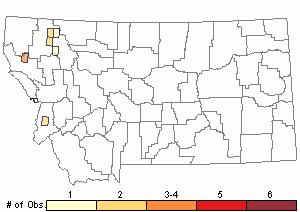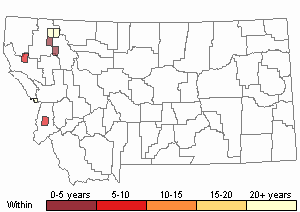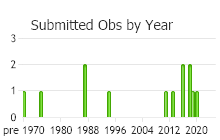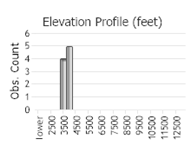View in other NatureServe Network Field Guides
NatureServe
Montana
Utah
Wyoming
Idaho
Wisconsin
British Columbia
South Carolina
Yukon
California
New York
A Peatmoss - Sphagnum centrale
General Description
Plants: Forming lawns or short, uncrowded hummocks to more densely-packed, less yielding mounds; shaded plants green, exposed forms somewhat mustard-colored or ochre, sometimes touched with pink; stem leaves a little distant to slightly compact; the crowded stem branches (capitula) quite rounded (FNA 2007).
Stems and Stem Leaves: Stems light to medium brown. Stem leaves seldom similar to the branch leaves, somewhat tongue-shaped with an obtuse, rounded apex, the edge fringed, the outer surface frequently reassimilated and eroded away, 1.2-2.2 mm in length, 0.8-1 mm in width (FNA 2007).
Branches and Branch Leaves: Branch stems green, narrowing, dimorphic, the fascicles consisting of 1-2 pendent branches and 2 spreading branches. Branch leaves up to 1.7 mm in length and to 1.5 mm in width, widely egg-shaped, the apex hood-shaped (concave with the edges folded inward), the apical margin denticulate (FNA 2007).
Stem and Stem Leaf Cells: Stem hyaline cells swollen and thin-walled, in 3-4 layers, the spiraling fibrils that strengthen the outermost layer of cortical cells distinct, the inner cell walls lacking comb fibrils, each cell with 2 or more pores. Stem leaf hyaline cells seldom divided, lacking comb lamellae and ornamentation (FNA 2007).
Branch and Branch Leaf Cells: Branch stem cortical cells frequently possessing large round pores on the outermost walls, lacking ornamentation; retort cells not present. Branch leaf hyaline cells lacking ornamentation, pores typically 1 at each angle where 3 hyaline cells meet (thus often found in 3s), the convex (outer) leaf surface displaying mostly elliptic pores (seldom round) on the margins contiguous to the green cells; green (chlorophyllous) cells in X-section lens-shaped and slightly elongated or slenderly quadrangular, exposed a little more on the concave than on the convex surface, the end walls at both surfaces thickened (FNA 2007).
Phenology
Capsules ripen in late summer (FNA 2007).
Diagnostic Characteristics
The similar S. palustre frequently displays a reddish tint whereas S. centrale does not (FNA 2007).
Range Comments
North American Range
AK, NT, across southern Canada from BC to NL (except MB), in the northeastern states from MN and IA e to NJ and ME (except RI), and the western states of WA, ID, and MT. Found also in Greenland and Eurasia (FNA 2007). Known in Montana from Flathead and Ravalli Counties (Elliott 2016).
Observations in Montana Natural Heritage Program Database
Number of Observations: 13
(Click on the following maps and charts to see full sized version)
Map Help and Descriptions
Relative Density

Recency



 (Observations spanning multiple months or years are excluded from time charts)
(Observations spanning multiple months or years are excluded from time charts)
Habitat
Shaded, rich or moderately rich fens, frequently calcareous, especially where the water level varies with the seasons (Crum and Anderson 1981), particularly noticeable in fens of both sedge and conifer communities (FNA 2007).
Reproductive Characteristics
Dioicous. Fruiting uncommon. Pseudostomata on capsule not obvious (FNA 2007).
References
- Literature Cited AboveLegend:
 View Online Publication
View Online Publication Elliott, J.C. and A.K. Pipp. 2018. A Checklist of Montana Mosses (1880-2018). Updated 3 January, 2020. Montana Natural Heritage Program, Helena, Montana. 73 pp.
Elliott, J.C. and A.K. Pipp. 2018. A Checklist of Montana Mosses (1880-2018). Updated 3 January, 2020. Montana Natural Heritage Program, Helena, Montana. 73 pp. Flora of North America Editorial Committee, eds. 2007. Flora of North America North of Mexico. Volume 27. Bryophytes: Mosses, Part 1. Oxford University Press, Inc., NY. xxi + 713 pp.
Flora of North America Editorial Committee, eds. 2007. Flora of North America North of Mexico. Volume 27. Bryophytes: Mosses, Part 1. Oxford University Press, Inc., NY. xxi + 713 pp.
- Additional ReferencesLegend:
 View Online Publication
View Online Publication
Do you know of a citation we're missing? Crum, H.A. and L.E. Anderson. 1981. Mosses of Eastern North America. 2 volumes. Columbia University Press, New York. 1328 pp.
Crum, H.A. and L.E. Anderson. 1981. Mosses of Eastern North America. 2 volumes. Columbia University Press, New York. 1328 pp. Elliot, J. C. 1993. Second checklist of Montana mosses. Unpublished report. U.S. Forest Service, Region 1. Missoula, MT. 45 pp.
Elliot, J. C. 1993. Second checklist of Montana mosses. Unpublished report. U.S. Forest Service, Region 1. Missoula, MT. 45 pp. Lawton, E. 1971. Keys for the Identification of the Mosses on the Pacific Northwest. Reprinted from 'Moss Flora of the Pacific Northwest'. Published as Supplement No. 2 of the Journal of the Hattori Botanical Laboratory. Nichinan, Miyazaki, Japan. 66 pp.
Lawton, E. 1971. Keys for the Identification of the Mosses on the Pacific Northwest. Reprinted from 'Moss Flora of the Pacific Northwest'. Published as Supplement No. 2 of the Journal of the Hattori Botanical Laboratory. Nichinan, Miyazaki, Japan. 66 pp. Lawton, E. 1971. Moss Flora of the Pacific Northwest. Hattori Botanical Laboratory. Japan: Yamabuki-cho, Shinjuku-ku, Tokyo. 362 pages plus appendices.
Lawton, E. 1971. Moss Flora of the Pacific Northwest. Hattori Botanical Laboratory. Japan: Yamabuki-cho, Shinjuku-ku, Tokyo. 362 pages plus appendices.
- Web Search Engines for Articles on "A Peatmoss"





